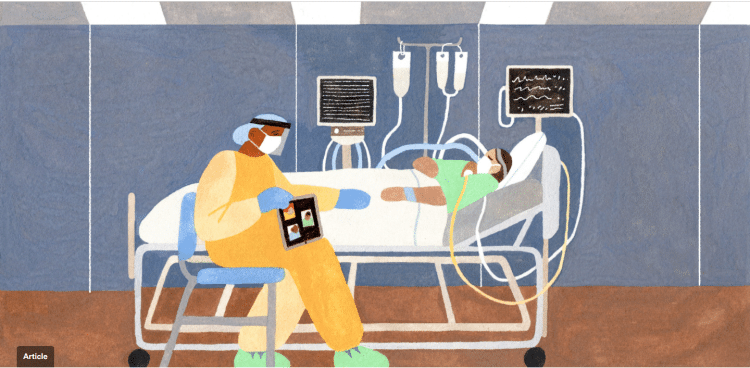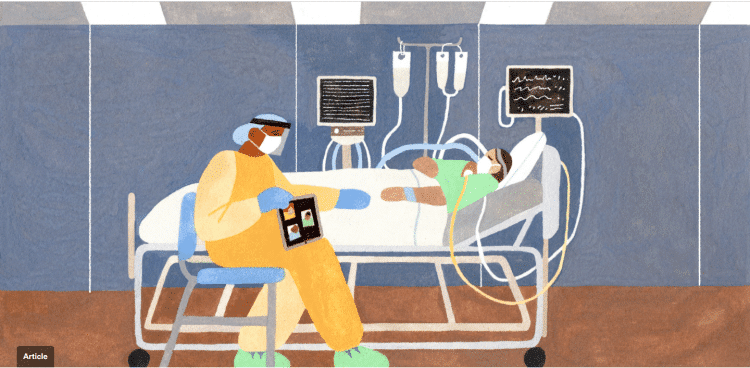Saying Goodbye on FaceTime
Impact of Tech

This article was written in partnership with Healthy Debate, and is part of a series of seven articles that explore the relationship between technology and compassion in the field of health care today, and especially during the COVID-19 pandemic.
Just before the 61-year-old man gasping for air was sedated and intubated in a Peel Region hospital, registered nurse Naila Shaikh used the man’s phone to call his son on FaceTime. The son had asked to see his father one last time upon learning he needed life support, and now, approximately six faces appeared on the phone’s screen. Shaikh held it up to his face. “His entire family watched him struggle to breathe,” she recalled.
Since the man could hardly talk, Shaikh tried to speak for him and answered the family’s questions about intubation. When she noticed the respiratory therapists and physicians donning their personal protective equipment outside the glass walls of the man’s room, she told the family, “It’s almost time.”
The man’s relatives tried hard to maintain their composure. Holding back tears, the son said, “You’ll be OK, Dad,” Shaikh recalled.
The father caught his breath enough to say, “I’ll be all right. I’ll see you soon.”
Shaikh turned the phone on herself, smiled with her eyes over her masked mouth, and said, “We’re going to do our best to take care of him.” She hung up.
Participating in that call was “gut-wrenching,” Shaikh said, but she realized that to maintain the emotional stamina she would need to make it through the pandemic, she would “have to change (her) perspective.” She decided to consider it “a privilege to be a part of such an intimate family moment.”
The combination of sadness and gratitude that Shaikh felt is reflective of a larger set of bittersweet experiences that have transpired in hospitals and long-term care homes throughout the pandemic: Health-care workers, primarily nurses, have been using platforms such as Zoom and FaceTime to host virtual visits between patients who are critically ill or dying from COVID-19 and their loved ones. Acting as the intermediary who enables these visits by holding up iPads and phones to ill patients is having a profound emotional effect on many health-care workers. While it is contributing to a state of emotional depletion and trauma for some, this responsibility has also become a source of solace for others. In turn, this experience is shedding light on some of the working conditions that are contributing to the burnout that is so widespread among nurses, even as it highlights how moments of intimate human connection are helping some health-care workers cope with their own feelings of shellshocked exhaustion.
Burnout “is very much exacerbated by the depersonalization of technologies,” Brian Hodges, a psychiatrist and chief medical officer of the University Health Network, said. Most health-care workers “went into health care because we need to and like to be in close proximity to other human beings,” and so interacting with grieving loved ones in this “brutally cold, technologically mediated way … would feel foreign to them.”
Jennifer Lapum, a nursing professor at Ryerson University, and several other researchers interviewed nurses who facilitated these video calls as part of a larger study, published in December 2020, that catalogued the common emotions felt by nurses working in acute-care settings during the first wave of COVID-19. The video calls were often intensely upsetting for the nurses. “These nurses … felt broken through this process,” Lapum recalled.
One reason why is that while Zoom, Skype and FaceTime can show a family a patient, the family still cannot hold that patient’s hand, caress their shoulder, or give them a hug – and “the emotional distress that this causes for a nurse is absolutely severe,” Lapum said. Nurses tend to be highly empathetic, she said, and they internalize the anguish that family members feel from being so distant from a loved one who is dangerously ill or dying.
This distance can also leave nurses feeling helpless. Lapum’s study quotes one nurse who facilitated a goodbye over video as saying: “Not being able to console family members … watching their hearts break, it takes a part of your soul … After those traumatic moments happen, you leave a little more empty.”
Stephanie Horner, a registered practical nurse who worked in a long-term care home during the first wave, had to use even cruder, more alienating technology: a telephone. She would call residents’ family members to inform them their loved ones had died of COVID-19. Responding to the disembodied cries of sorrow or drawn-out silences was “very uncomfortable” since she couldn’t communicate non-verbally, as she normally would have, by placing a hand on someone’s back or giving a sympathetic look. After these calls, physical and mental exhaustion would wash over her. “I would feel it right away,” she said. “It would hit me really hard.”
The sorrow and exhaustion caused by these sorts of calls would be more manageable if nurses were not extremely overworked during the pandemic. “You need time to deal with those emotions,” Lapum said, “and nurses aren’t getting that time.” Instead, nurses are scrambling: Many are working overtime and double shifts multiple times a week, sometimes without breaks more than a few minutes long; colleagues call in sick because they are self-isolating or struggling to handle the stress, leaving those who show up even more overburdened. ICU nurses are stretched so thin that they’re caring for more than twice the normal number of patients. Moreover, when nurses go home, many can’t sleep, or they suffer from “vivid nightmares, like blood dripping off of the bed or a (dying) patient that’s sitting there that they just can’t get to,” Lapum said. The next morning, the cycle repeats. More patients die in rapid succession, as if on “a conveyor belt,” Horner said.
The level of distress and exhaustion among nurses has reached a severity and scale that are alarming: A survey released last month by the Registered Nurses Association of Ontario (RNAO) found that stress levels were either “very high” or “high” for 60.3 per cent of respondents, and 26.2 per cent reported having taken time off “to manage stress, anxiety or other mental health issues due to the pandemic.” Just over half of the nurses who worked in long-term care homes in which there was an outbreak of COVID-19 during the first wave reported having developed symptoms of PTSD, according to a survey by the Ontario Nurses Association. Two registered nurses have even died by suicide, said Doris Grinspun, the CEO of the RNAO.
In another survey, released by WeRPN, the organization representing Ontario’s registered practical nurses, 71 per cent of respondents said that the pandemic had pushed them to a “breaking point,” and 83 per cent reported that the pandemic had adversely affected their mental health. The WeRPN survey drew attention in particular to the “personal toll” of “witnessing final good-byes and supporting loved ones” who could not be present for a loved one’s death in person. “This experience … represents an intimate bond shared between nurse and patient, but is not without its own personal challenges,” states the report. But sometimes, this intimate bond can be restorative too.
Barbara Michalik is the director of community and academic partnerships and programs at the Rekai Centres, a non-profit that operates two long-term care homes in downtown Toronto. During the first wave a year ago, she helped out with providing hands-on, bedside care to the home’s residents. One day, outfitted in personal protective equipment and carrying an iPad, she entered the room of an elderly man ill with COVID-19. His condition was worsening. She knelt beside him and held the iPad up to his face. The face of the man’s son, long estranged from his father, appeared on screen.
As the man’s life neared its end, his son left nothing unsaid: “I forgive you,” Michalik recalls him saying, “and I want to say I’m sorry for everything that I have done.”
The father nodded intermittently. “You could just see the light in (his) eyes,” Michalik recalled. Tears slid down his cheeks. “I want to let you know that I’m going to be a good father … and you are going to be a grandfather,” the son continued.
Michalik was crying so hard that the iPad trembled in her hand. She forgot about the chaos awaiting her outside the man’s room, and even felt as if there was “a light shining on us, like a spotlight,” she said. “I’ve never felt that before.”
After the call, Michalik congratulated the man on the upcoming birth of his first grandchild, squeezing his hand as he gripped hers back. He smiled up at her. He died the next day.
“That light shining down … that bond with that family … that’s what makes all of us keep going,” Michalik said.

Related
‘You need not be alone anymore’: The doctor redefining palliative care
Palliative care physicians were no longer on-call consultants or experts brought in only when it became clear that a patient was forgoing curative or life-prolonging medical treatment. They became a fixture of the emergency department.
Could AI make health care more human?
CHARTwatch, is a tool that uses artificial intelligence (AI) to continuously monitor the medical status of patients on Saint Michael’s General Internal Medicine unit.
How one ER partnered with a mental-health organization to care for youth in distress
First-hand knowledge of what it’s like to struggle with mental illness and substance use – and what it takes to recover – complements the clinical expertise of the ER team.

